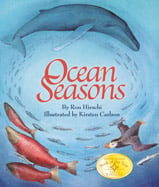Alignment to Standards for MI

| Grade | Number | Standard |
|---|---|---|
| 1 | E.ES.01.22 | Describe and compare weather related to the four seasons in terms of temperature, cloud cover, precipitation, and wind. |
| 1 | E.ES.E.2 | Weather changes from day to day and over the seasons. |
| 1 | E.SE.01.12 | Describe how Earth materials contribute to the growth of plant and animal life. |
| 1 | L.HE.01.11 | Observable Characteristics- Plants and animals share many, but not all, characteristics of their parents. |
| 1 | L.HE.01.11 | Identify characteristics (for example: body coverings, beak shape, number of legs, body parts) that are passed on from parents to young. |
| 1 | L.HE.01.12 | Classify young animals based on characteristics that are passed on from parents (for example: dogs/puppies, cats/kittens, cows/calves, chicken/chicks). |
| 1 | L.OL.01.21 | Describe the life cycle of animals including the following stages: egg, young, adult; egg, larva, pupa, adult. |
| 1 | L.OL.E.2 | Plants and animals have life cycles. Both plants and animals begin life and develop into adults, reproduce, and eventually die. The details of this life cycle are different for different organisms. |
| 2 | E.FE.02.11 | Identify water sources (wells, springs, lakes, rivers, oceans). |
| 2 | E.FE.02.12 | Identify household uses of water (drinking, cleaning, food preparation). |
| 2 | E.FE.02.21 | Describe how rain collects on the surface of the Earth and flows downhill into bodies of water (streams, rivers, lakes, oceans) or into the ground. |
| 2 | E.FE.02.22 | Describe the major bodies of water on the Earthês surface (lakes, ponds, oceans, rivers, streams). |
| 2 | E.FE.E.1 | Water is a natural resource and is found under the ground, on the surface of the earth, and in the sky. It exists in three states (liquid, solid, gas) and can go back and forth from one form to another. |
| 2 | E.SE.02.21 | Describe the major landforms of the surface of the Earth (mountains, plains, plateaus, valleys, hills). |
| 2 | L.HE.02.13 | Identify characteristics of plants (for example: leaf shape, flower type, color, size) that are passed on from parents to young. |
| 2 | L.HE.E.1 | Observable Characteristics- Plants and animals share many, but not all, characteristics of their parents. |
| 2 | L.OL.E.2 | Plants and animals have life cycles. Both plants and animals begin life and develop into adults, reproduce, and eventually die. The details of this life cycle are different for different organisms. |
| 3 | E.ES.03.51 | humans are dependent on the natural environment (forests, water, clean air, earth materials) and constructed environments (homes, neighborhoods, shopping malls, factories, and industry). |
| 3 | E.ES.E.4 | The supply of many natural resources is limited. Humans have devised methods for extending their use of natural resources through recycling, reuse, and renewal. |
| 3 | E.ES.E.5 | Humans depend on their natural and constructed environment. Humans change environments in ways that are helpful or harmful for themselves and other organisms. |
| 3 | L.EV.03.11 | characteristics and functions of observable parts in a variety of plants that allow them to live in their environment (for example: leaf shape, thorns, odor, color). |
| 3 | L.EV.03.12 | characteristics and functions of observable body parts to the ability of animals to live in their environment (for example: sharp teeth, claws, color, body covers). |
| 3 | L.EV.E.1 | Different kinds of organisms have characteristics that help them to live in different environments. |
| 3 | L.OL.03.32 | Identify and compare structures in animals used for controlling body temperature, support, movement, food-getting, and protection (for example: fur, wings, teeth, claws). |
| 3 | L.OL.E.3 | Organisms have different structures that serve different functions in growth, survival, and reproduction. |
| 4 | 4 _ G1.0.4 | Use geographic tools and technologies, stories, songs, and pictures to answer geographic questions about the United States. |
| 4 | L.EC.04.11 | Identify organisms as part of a food chain or food web. |
| 4 | L.EC.E.1 | Organisms interact in various ways including providing food and shelter to one another: Some helpful: others are harmful to the organism and other organisms. |
| 5 | E.ES.M.6 | Seasons- Seasons result from annual variations in the intensity of sunlight and length of day due to the tilt of the axis of the Earth relative to the plane of its yearly orbit around the sun. |
| 5 | L.EV.05.11 | Explain how behavioral characteristics (adaptation, instinct, learning, habit) of animals help them to survive in their environment. |
| 5 | L.EV.05.12 | Describe the physical characteristics (traits) of organisms that help them survive in their environment. |
| 5 | L.HE.05.12 | Distinguish between inherited and acquired traits. |
| 5 | L.HE.M.1 | Inherited and Acquired Traits - The characteristics of organisms are influenced by heredity and environment. For some characteristics, inheritance is more important; for other characteristics, interactions with the environment are more important. |